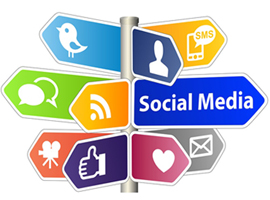
Think about it this way, if people are landing on your thank you page, they are already ready to participate and help your business. By putting together a typical thank you message you are giving them permission to leave your site without further action, so why not engage to stay instead? The best part about optimizing your thank you page is that it is an easy update that won’t take a lot of time to do.
How to Optimize Your Thank You Page on an E-Commerce Site
The first thing to keep in mind is that it’s not necessary to do all of the following steps or tips. Sometimes just one or two will be good enough to help you get the information you need without overwhelming or annoying customers.
KISSMetrics wrote the article to reference when thinking about Thank You pages here, so below are a few of their ideas along with some of our own below:
Add Your Social Media Links to the Page for Easy Following

Ask them to Share your Website or Share What They Bought
It has been in recent blogging news that Google is starting to place more weight on social sharing in the SEO world, so why not take the opportunity to increase sharing with your Thank You page?
Unfortunately, having social media buttons on every page of your website does not necessarily translate to having your page shared. The best approach is actually to explicitly ask your visitors to share (as opposed to follow, which was the last point). The good news is that if they already subscribed to your site, they may just be in the mood to help you out and share your page as well after they’ve made a purchase. You may also want to give them the option to share what they just purchased so all of their friends can be in the loop. People love to show off on social media, so use this!
Prompt Others to Join Your Forums and Online Community
This is something that is brought up time and time again, but participating in your online community is one of the best ways you can raise awareness about your brand. This can easily translate to your Thank You page. Use your Thank You page to encourage visitors to participate in your other community-oriented features like podcasts, forums, etc.
Mention Special Promotions and Newly Launched Products
Generally when you see promotions and CTAs involving promotions, they are not on the Thank You page. However, you already know that visitors who have found your Thank You page after subscribing are hot prospects, so take the opportunity to promote things like special offers or new products you’re about to launch. It makes them feel special!
I will have to add, however, that you should tread lightly if you choose to go this route simply because it’s so easy to annoying customers, and these are now your most important customers because they’ve actually converted. In other words, don’t push your luck. Only use this tactic if you’ve tested it and have a good feeling about those who shop on your website.
Add Links to Your Best and Most-Relevant Content
Adding links to your best content turns your Thank You page into a helpful resource that can lead some of your new prospects to information they are looking for or items they are ready to purchase. Additionally, adding links to the best content on your site can also allow your visitors to view you as an expert in your area and benefit your SEO. In case that isn’t enough good news, it is also more likely these items (and your site) will be shared on social media as well.
Some ideas of the types of content you can link to on your thank you page include most popular blog posts, infographics, reviews, interviews, videos, and guides and tutorials.
Show Testimonials from Past Customers

Extra: Most e-commerce companies will put testimonials on their homepages and then Thank You pages would be the next step, but testimonials can also work great on any page where you’re offering information. If you check out this page from NoRiskSEO you’ll see that we’re talking about pharmaceuticals but still managed to keep a testimonials on the right-hand sidebar of the page.
Consider Creating a Survey
Surveys are a quick, easy, and inexpensive way to get feedback. All you have to do is come up with a few questions and paste a link on your Thank You page for readers to participate. Keep it short, sweet, and to the point. Let visitors know the time it will take to complete the survey and make sure your objective is clear so that you can get the information you are after. SurveyMonkey is probably your best option when it comes to creating a great survey, so check that tool out here.
See What You Can Learn about Your Customers
One of the best strategies for optimizing customer relations is getting to know the individual customers and visitors better. All you have to do is ask your Thank You page visitors to answer a few questions by leaving a comment. You can then use this information to generate new content or even products and services that you know your audience needs.
Ultimately, asking for feedback gives you a better understanding of how your customers and site visitors interact with your site and what they think of your products and services. Providing an opportunity for feedback gives you the chance to get information directly from the source so that you can see what works well and what might need improvement. As with other areas of your website where you might already ask for feedback, using the comments section of your Thank You page (or adding an additional form to it) allows visitors to submit their feedback.
Do you have experience or other ideas for optimizing the thank you page for website subscribers? Let us know in the comments section below.

